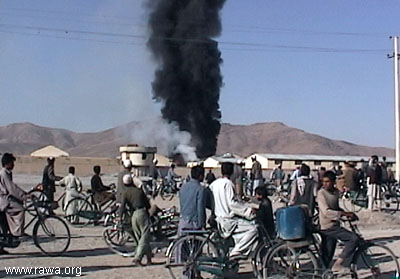US Jets Hit Red Cross in Kabul
AP, October 26, 2001
By MATT KELLEY, Associated Press Writer
 | |
More photos |
US jets bombed the Afghan capital of Kabul, hitting a Red Cross compound for a second time this month and damaging food and other humanitarian supplies.
At the Pentagon, a senior officer said a Red Cross warehouse may have been damaged but he had no details. Rear Adm. John Stufflebeem said U.S. officials were looking into the matter.
He offered no details on Friday's airstrikes. He said Thursday's attacks targeted Taliban forces as well as cave complexes where Taliban or al-Qaida troops were believed to be hiding.
Stufflebeem said 10 different target areas - including ammunition depots and other military sites - were struck Thursday by bombs and missiles from about 80 warplanes, including about 70 Navy F-14s and F-18s launched from aircraft carriers in the Arabian Sea. A small number of Tomahawk cruise missiles also were fired Thursday, he said.
Struggling with longer-range problems, the Pentagon asked private companies to help develop high-tech solutions the military would need in the fight against terrorism - including ways to defuse biological and chemical weapons.
"The current methods are crude and cause collateral damage," the Pentagon said Thursday of bomb disposal methods. Instead, the military is seeking ways to expose the inner workings of such bombs so they can be neutralized without releasing their deadly contents.
Three big explosions shook Kabul at midday Friday, raising clouds of smoke from the direction of the airport and the Khair Khana district to the north. One of the blasts struck the same Red Cross compound that was hit during an Oct. 16 attack, according to security guard Abdul Shakour.
He said warehouses used to store humanitarian supplies were damaged and stocks of rice, beans, blankets and oil were on fire.
In Great Britain, officials said they will raise their participation in the campaign. They are already flying refueling and reconnaissance aircraft in support of U.S. airstrikes and have fired Tomahawk cruise missiles from a submarine in the Arabian Sea.
Armed Forces Minister Adam Ingram told Parliament that 200 commandos of the Royal Marines would be based on assault ships in the region, ready for operations in Afghanistan. Another 400 commandos would be on standby in Britain, he said.
The United States has said it is not planning a large ground effort in Afghanistan, in comparison to some previous wars, but is using smaller assaults to root out al-Qaida terrorist cells and the Taliban. Last weekend more than 100 U.S. special operations troops raided an air field and Taliban compound in southern Afghanistan to collect intelligence. Other U.S. teams have been working in the north to help rebels opposing the Taliban, and agents have worked in the south to try to win defections from the Taliban.
On Thursday, American warplanes unleashed the heaviest strikes on Kabul in several days and hit Taliban troops north of Kabul and near the northern city of Mazar-e-Sharif.
Gen. Richard Myers, chairman of the Joint Chiefs of Staff, acknowledged the campaign over Afghanistan has included the use of cluster bombs, munitions normally carrying up to 200 three-pound bomblets that spray shrapnel at the velocity of a bullet.
The cluster bombs penetrate armor. Myers said he was unaware of a United Nations report earlier this week that unexploded cluster bombs had trapped residents in a west Afghan village.
The Pentagon also asked private industry for anti-terrorism ideas that could lead to solutions within a year or 18 months. Among the ideas the military seeks are ways to detect chemical or biological warfare agents before they are released - with the goal of gaining a two-minute warning against several deadly agents, including nerve gases and bacteria such as anthrax and the plague.
The request also sought help in protecting and sustaining small commando forces in hostile terrain, mapping caves and improving devices that can essentially see through walls.
The Pentagon is also asking for a system that can recognize the Afghan languages of Pashtu, Farsi and other Arab and South Asian dialects from 10-second to 30-second snippets of conversation. That system would be incorporated into an existing Automated Speaker Recognition System.
Another high-tech snooping tool the Pentagon needs is a way to use voice prints to identify specific individuals. The military also wants a software modeling system to show patterns of terrorist activity, which then could be used to disrupt terrorist networks.